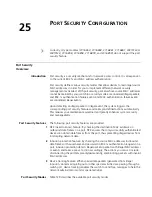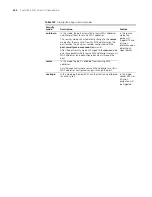
Overview
185
port, you cannot remove the port unless you remove the whole aggregation
group.
LACP is enabled on the member ports of static aggregation groups, and disabling
LACP on such a port will not take effect. When you remove a static aggregation
group, the system will remain the member ports of the group in LACP-enabled
state and re-aggregate the ports to form one or more dynamic LACP aggregation
groups.
Port status of static aggregation group
A port in a static aggregation group can be in one of the two states: selected or
standby. Both the selected and the standby ports can transceive LACPDUs
however, the standby ports cannot forward user packets.
n
In an aggregation group, the selected port with the minimum port number serves
as the master port of the group, and other selected ports serve as member ports
of the group.
In a static aggregation group, the system sets the ports to selected or standby
state according to the following rules:
■
The system sets the “most preferred” ports (that is, the ports take most
precedence over other ports) to selected state, and others to standby state.
Port precedence descends in the following order: full duplex/high speed, full
duplex/low speed, half duplex/high speed, half duplex/low speed.
■
The system sets the following ports to standby state: ports that are not
connected to the same peer device as the master port (selected port with the
minimum port number), and ports that are connected to the same peer device
as the master port but not in the same aggregation group as the master port.
■
The system sets the ports unable to aggregate with the master port (due to
some hardware limit, for example, cross-board aggregation unavailability) to
standby state.
■
The system sets the ports with basic port configuration different from that of
the master port to standby state.
There is a limit on the number of selected ports in an aggregation group.
Therefore, if the number of the member ports that can be set as selected ports in
an aggregation group exceeds the maximum number supported by the device, the
system will choose the ports with lower port numbers as the selected ports, and
set others as standby ports.
n
For the restriction of I/O Module types on link aggregation, refer to Table 120 and
Table 121.
Dynamic LACP
Aggregation Group
Introduction to dynamic LACP aggregation group
A dynamic LACP aggregation group is automatically created and removed by the
system. Users cannot add/remove ports to/from it. Ports can be aggregated into a
dynamic aggregation group only when they are connected to the same peer
device and have the same basic configuration (such as rate and duplex mode).
Summary of Contents for Switch 7757
Page 32: ...32 CHAPTER 1 CLI OVERVIEW...
Page 70: ...70 CHAPTER 5 LOGGING IN USING MODEM...
Page 76: ...76 CHAPTER 7 LOGGING IN THROUGH NMS...
Page 86: ...86 CHAPTER 9 CONFIGURATION FILE MANAGEMENT...
Page 120: ...120 CHAPTER 13 ISOLATE USER VLAN CONFIGURATION...
Page 126: ...126 CHAPTER 14 SUPER VLAN...
Page 136: ...136 CHAPTER 16 IP PERFORMANCE CONFIGURATION...
Page 152: ...152 CHAPTER 17 IPX CONFIGURATION...
Page 164: ...164 CHAPTER 19 QINQ CONFIGURATION...
Page 172: ...172 CHAPTER 21 SHARED VLAN CONFIGURATION...
Page 182: ...182 CHAPTER 22 PORT BASIC CONFIGURATION...
Page 198: ...198 CHAPTER 24 PORT ISOLATION CONFIGURATION...
Page 208: ...208 CHAPTER 25 PORT SECURITY CONFIGURATION...
Page 224: ...224 CHAPTER 27 DLDP CONFIGURATION...
Page 232: ...232 CHAPTER 28 MAC ADDRESS TABLE MANAGEMENT...
Page 240: ...240 CHAPTER 29 CENTRALIZED MAC ADDRESS AUTHENTICATION CONFIGURATION...
Page 280: ...280 CHAPTER 30 MSTP CONFIGURATION...
Page 348: ...348 CHAPTER 35 IS IS CONFIGURATION...
Page 408: ...408 CHAPTER 39 802 1X CONFIGURATION...
Page 412: ...412 CHAPTER 40 HABP CONFIGURATION...
Page 422: ...422 CHAPTER 41 MULTICAST OVERVIEW...
Page 426: ...426 CHAPTER 42 GMRP CONFIGURATION...
Page 480: ...480 CHAPTER 47 PIM CONFIGURATION...
Page 506: ...506 CHAPTER 48 MSDP CONFIGURATION...
Page 552: ...552 CHAPTER 51 TRAFFIC ACCOUNTING CONFIGURATION...
Page 570: ...570 CHAPTER 53 HA CONFIGURATION...
Page 582: ...582 CHAPTER 54 ARP CONFIGURATION SwitchA arp protective down recover interval 200...
Page 622: ...622 CHAPTER 58 DHCP RELAY AGENT CONFIGURATION...
Page 684: ...684 CHAPTER 61 QOS CONFIGURATION...
Page 718: ...718 CHAPTER 63 CLUSTER...
Page 738: ...738 CHAPTER 67 UDP HELPER CONFIGURATION...
Page 752: ...752 CHAPTER 69 RMON CONFIGURATION...
Page 772: ...772 CHAPTER 70 NTP CONFIGURATION...
Page 796: ...796 CHAPTER 72 FILE SYSTEM MANAGEMENT...
Page 802: ...802 CHAPTER 73 BIMS CONFIGURATION...
Page 814: ...814 CHAPTER 74 FTP AND TFTP CONFIGURATION...
Page 830: ...830 CHAPTER 75 INFORMATION CENTER...
Page 836: ...836 CHAPTER 76 DNS CONFIGURATION...
Page 852: ...852 CHAPTER 77 BOOTROM AND HOST SOFTWARE LOADING...
Page 858: ...858 CHAPTER 78 BASIC SYSTEM CONFIGURATION DEBUGGING...






























